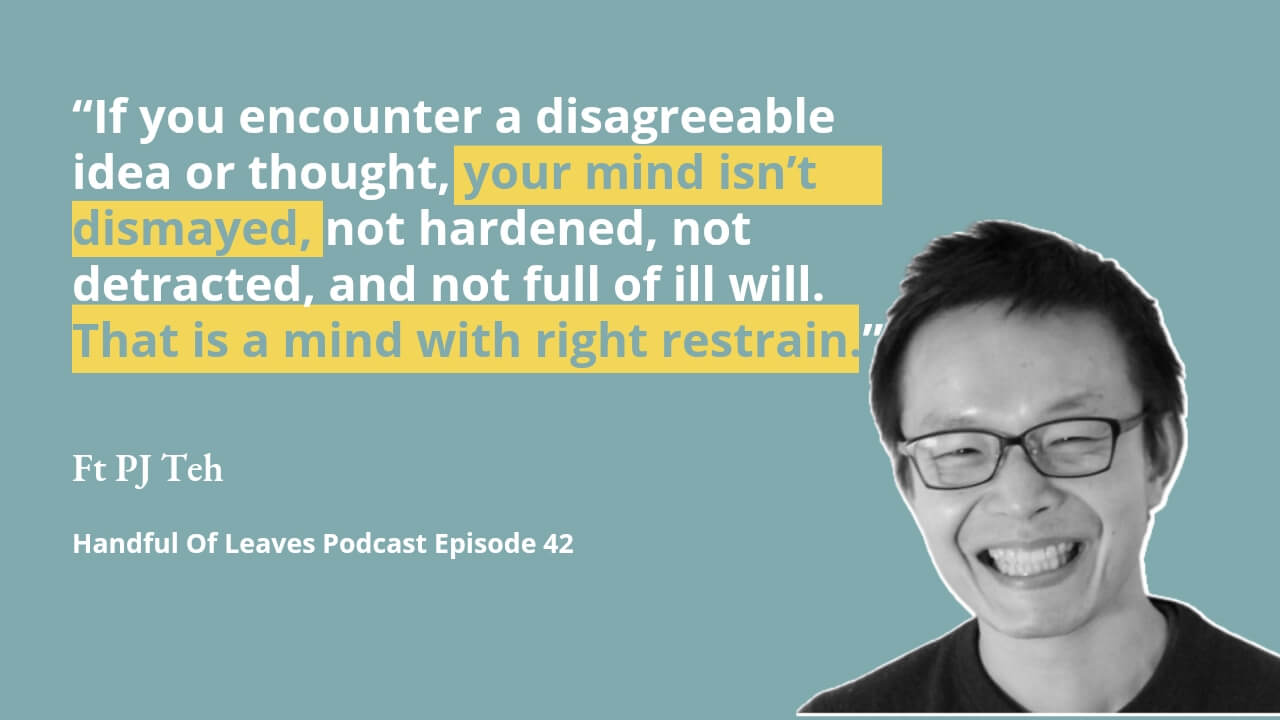About the Speaker
PJ is someone who discovered Buddhism while procrastinating as a student and later discovered Ajahn Brahm and the Suttas in the executive retreat of 2010 in Chiang Rai.
He procrastinated again on the spiritual path through various roles with the Singapore Economic Development Board (EDB), including industry development and strategic planning. He’s taking his time now working towards being a nobody.
‘Restrain’ in this modern world of freedom and enjoyment seems like a curse word. So when one says restrain leads to peace, to calm and to stillness, what does that truly mean? Cheryl and PJ discusses this.
Exploring the Concept of Sense Restraint
Sense restraint stands as a fundamental principle in Buddhist philosophy, elucidating the practice of maintaining control over one’s senses to foster inner peace and spiritual development. Rooted in the teachings of the Buddha, sense restraint emphasizes the importance of mindful awareness and moderation in engaging with the external world.
Common Misconceptions
Despite its profound significance, sense restraint often faces misconceptions and misinterpretations. Some individuals perceive it as a form of suppression or denial, equating restraint with restriction. However, in the context of Buddhism, sense restraint entails a balanced approach to sensory experiences, avoiding excessive indulgence or aversion.
Amplifying the Need for Right Restraint
Cultivating Awareness and Mindfulness
At the core of sense restraint lies the cultivation of awareness and mindfulness. By developing a heightened sense of consciousness towards sensory stimuli, practitioners can discern between wholesome and unwholesome mental states. Through mindfulness practices such as meditation and reflection, individuals gain insight into the transient nature of sensory pleasures, fostering a deeper understanding of the impermanent nature of existence.
Recognizing Unwholesome Mental States
Central to the practice of sense restraint is the recognition and redirection of unwholesome mental states. By acknowledging the arising of desires, aversions, and attachments, practitioners can refrain from becoming ensnared by them. Instead of succumbing to impulsive reactions, individuals cultivate the wisdom to respond with equanimity and discernment, thereby breaking free from the cycle of suffering.
The Solution: Practicing Right Restraint
Mindfulness Techniques for Sense Restraint
Practicing sense restraint involves employing various mindfulness techniques to anchor one’s awareness in the present moment. Breath awareness, body scanning, and mindful observation of sensory experiences enable individuals to develop a non-reactive stance towards external stimuli. Through consistent practice, practitioners cultivate a sense of inner calm and tranquility, transcending the fleeting fluctuations of the mind.
Wisdom over Willpower
Contrary to conventional notions of restraint as an act of sheer willpower, Buddhism emphasizes the cultivation of wisdom in exercising right restraint. Rather than forcefully suppressing desires, individuals employ discernment and insight to navigate the complexities of sensory perception. By discerning the impermanent and unsatisfactory nature of worldly phenomena, practitioners gradually loosen the grip of attachment and craving, paving the way for genuine freedom and happiness.
Testimonials and Success Stories
Personal Experiences of Sense Restraint
Countless individuals have attested to the transformative power of practicing sense restraint in their daily lives. From overcoming addictive behaviors to cultivating greater inner peace and clarity, personal testimonials serve as compelling evidence of the profound impact of right restraint. By sharing their experiences, practitioners inspire others to embark on the path of self-discovery and spiritual growth.
Case Studies on the Impact of Sense Restraint
In addition to personal anecdotes, case studies offer valuable insights into the practical applications of sense restraint in various contexts. Whether in the realm of addiction recovery, mental health management, or interpersonal relationships, case studies highlight the efficacy of mindfulness-based interventions in promoting holistic well-being. By examining real-life examples of successful outcomes, individuals gain confidence in the transformative potential of practicing right restraint.
Tools and Resources for Practicing Sense Restraint
Meditation Practices for Mindfulness
Meditation serves as a cornerstone practice for cultivating mindfulness and sense restraint. Guided meditation techniques, such as breath meditation, loving-kindness meditation, and body scan meditation, provide practitioners with invaluable tools for developing present-moment awareness and mental clarity. Through consistent meditation practice, individuals strengthen their capacity to observe and regulate their sensory experiences, fostering a deep sense of inner peace and contentment.
Educational Materials on Buddhist Principles
For those seeking a deeper understanding of sense restraint and its philosophical underpinnings, a wealth of educational resources is readily available. From books and articles to online courses and workshops, aspiring practitioners can access a treasure trove of teachings on Buddhist principles. By immersing themselves in the wisdom of the Dharma, individuals gain profound insights into the nature of desire, attachment, and liberation, empowering them to cultivate right restraint in their lives.
Conclusion: Embracing Right Restraint for Inner Peace
Summary and Call to Action
In conclusion, sense restraint emerges as a potent tool for cultivating inner peace, wisdom, and spiritual liberation. By understanding the importance of mindfulness, wisdom, and moderation in sensory engagement, individuals can transcend the confines of craving and aversion, discovering profound freedom and happiness within themselves. As we embark on the journey of self-discovery and transformation, let us embrace the practice of right restraint with open hearts and steadfast dedication.
Final Thoughts
In the pursuit of inner peace and pure mind, the practice of sense restraint offers a path of profound transformation and liberation. Through mindfulness, wisdom, and compassionate self-reflection, individuals can navigate the complexities of existence with clarity, equanimity, and grace. As we cultivate right restraint in our daily lives, may we awaken to the inherent beauty and goodness that reside within us, realizing the boundless potential for healing, growth, and awakening.
Resources:
PJ Recommends to get started here:
Bhikkhu Bodhi: In the Buddha’s Words
Bhikkhu Nyanamoli: The Life of the Buddha
SuttaCentral , https://www.accesstoinsight.org/, https://suttafriends.org/
Special thanks to our sponsors:
Buddhist Youth Network, Lim Soon Kiat, Alvin Chan, Tan Key Seng, Soh Hwee Hoon, Geraldine Tay, Venerable You Guang, Wilson Ng, Diga, Joyce, Tan Jia Yee, Joanne, Suñña, Shuo Mei, Arif, Bernice, Wee Teck, Andrew Yam, Kan Rong Hui, Wei Li Quek, Shirley Shen, Ezra, Joanne Chan, Hsien Li Siaw, Gillian Ang, Wang Shiow Mei
Editor and transcriber of this episode: Cheryl Cheah, Susara Ng, Ke Hui Tee


